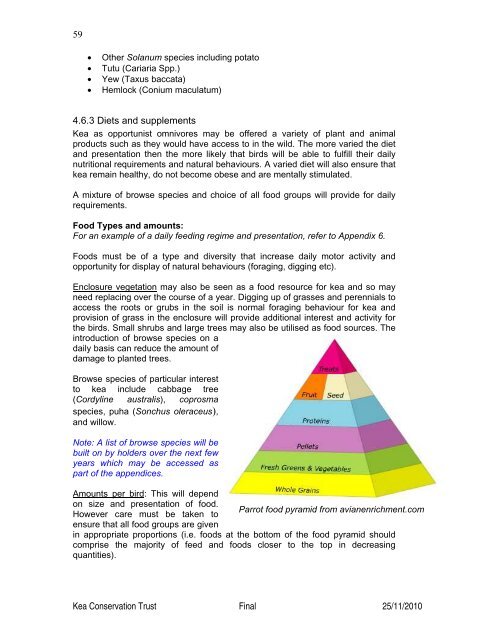(Nestor notabilis) Husbandry Manual - Kea Conservation Trust
(Nestor notabilis) Husbandry Manual - Kea Conservation Trust
(Nestor notabilis) Husbandry Manual - Kea Conservation Trust
Create successful ePaper yourself
Turn your PDF publications into a flip-book with our unique Google optimized e-Paper software.
59<br />
• Other Solanum species including potato<br />
• Tutu (Cariaria Spp.)<br />
• Yew (Taxus baccata)<br />
• Hemlock (Conium maculatum)<br />
4.6.3 Diets and supplements<br />
<strong>Kea</strong> as opportunist omnivores may be offered a variety of plant and animal<br />
products such as they would have access to in the wild. The more varied the diet<br />
and presentation then the more likely that birds will be able to fulfill their daily<br />
nutritional requirements and natural behaviours. A varied diet will also ensure that<br />
kea remain healthy, do not become obese and are mentally stimulated.<br />
A mixture of browse species and choice of all food groups will provide for daily<br />
requirements.<br />
Food Types and amounts:<br />
For an example of a daily feeding regime and presentation, refer to Appendix 6.<br />
Foods must be of a type and diversity that increase daily motor activity and<br />
opportunity for display of natural behaviours (foraging, digging etc).<br />
Enclosure vegetation may also be seen as a food resource for kea and so may<br />
need replacing over the course of a year. Digging up of grasses and perennials to<br />
access the roots or grubs in the soil is normal foraging behaviour for kea and<br />
provision of grass in the enclosure will provide additional interest and activity for<br />
the birds. Small shrubs and large trees may also be utilised as food sources. The<br />
introduction of browse species on a<br />
daily basis can reduce the amount of<br />
damage to planted trees.<br />
Browse species of particular interest<br />
to kea include cabbage tree<br />
(Cordyline australis), coprosma<br />
species, puha (Sonchus oleraceus),<br />
and willow.<br />
Note: A list of browse species will be<br />
built on by holders over the next few<br />
years which may be accessed as<br />
part of the appendices.<br />
Amounts per bird: This will depend<br />
on size and presentation of food.<br />
Parrot food pyramid from avianenrichment.com<br />
However care must be taken to<br />
ensure that all food groups are given<br />
in appropriate proportions (i.e. foods at the bottom of the food pyramid should<br />
comprise the majority of feed and foods closer to the top in decreasing<br />
quantities).<br />
<strong>Kea</strong> <strong>Conservation</strong> <strong>Trust</strong> Final 25/11/2010












